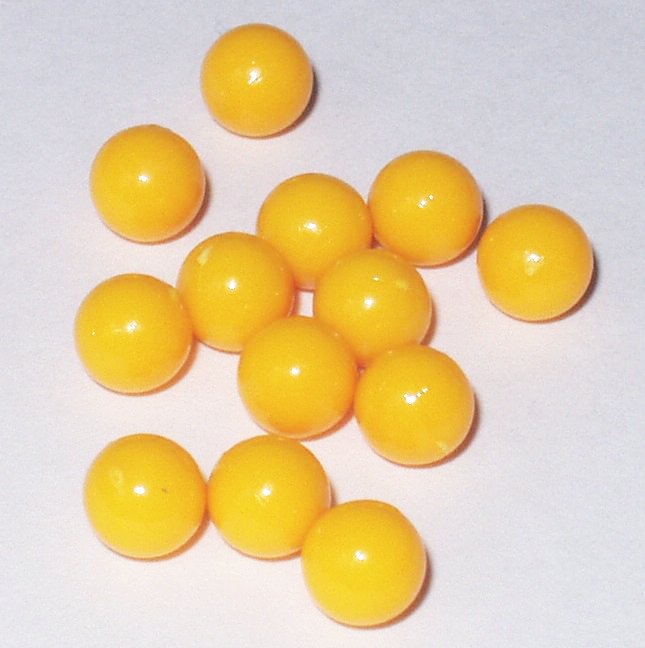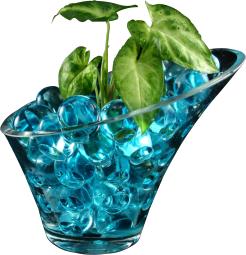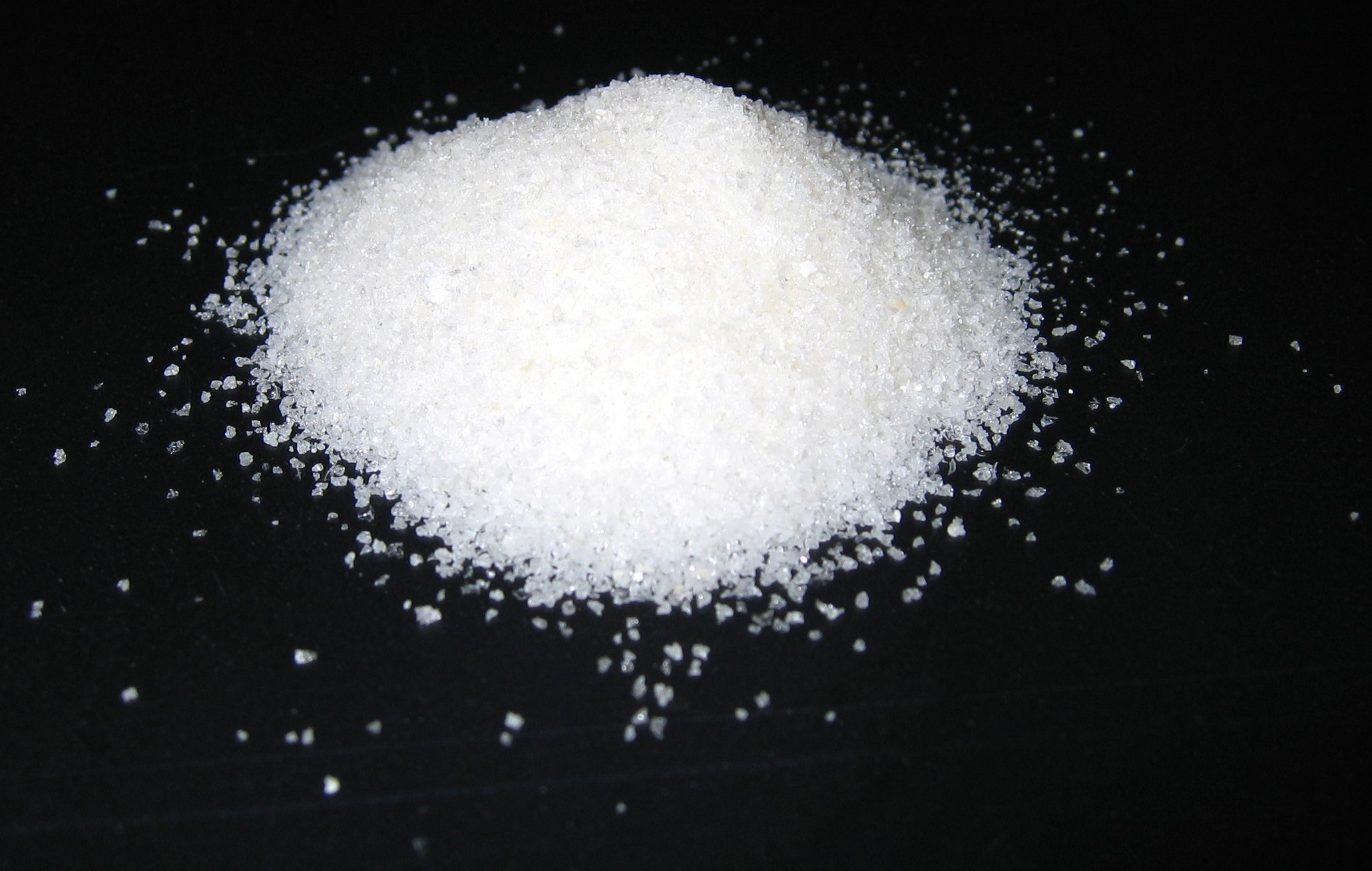|
Xploderz
Xploderz is a line of toy weapons made by The Maya Group to compete with Hasbro's Nerf Super Soaker line and marketed as a safer alternative to paintball. The concept is based on Orbeez, a girls' toy line also by The Maya Group that uses water-absorbent gel pellets, and hence is sometimes referred to as "Orbeez ball shooters". When playing, a piston rod is manually pulled back against spring tension in a fashion similar to drawing a slingshot, allowing pellets to be drop-loaded from a top mounted magazine. When the rod is released, the spring elasticity drives piston to pressurize the air pump behind the pellets, which in turn propels the pellets flying out forward. The ammunition used is what the Maya Group calls "H2Grow Technology", wherein superabsorbent polymer pellets (containing sodium polyacrylate, sodium hydroxide and colorings) grow into spherical hydrogel beads around 7 ~ 11 mm in size after being immersed in water for about three hours. Unlike airsoft a ... [...More Info...] [...Related Items...] OR: [Wikipedia] [Google] [Baidu] |
Super Soaker
Super Soaker is an American brand of recreational water gun that uses manually-pressurized air to shoot water with greater power, range, and accuracy than conventional squirt pistols. The Super Soaker was invented in 1989 by engineer Lonnie Johnson. The prototype combined PVC pipe, acrylic glass, and an empty plastic soda bottle. Originally sold by Larami and now produced by Hasbro under the Nerf brand, Super Soaker has generated more than $1 billion in total sales. The first Super Soaker went on sale in 1990 and was originally called the Power Drencher. Rebranding the name to Super Soaker occurred in 1991 together with a series of TV advertisements that resulted in 2 million water guns being sold. Super Soakers were popular for many years—so popular, in fact, that the term ''super soaker'' is sometimes used generically, to refer to any type of toy pressurized water gun. History In 1982 Air Force and NASA engineer Lonnie Johnson conceived of the idea of a pressurized ... [...More Info...] [...Related Items...] OR: [Wikipedia] [Google] [Baidu] |
Air Pump
An air pump is a pump for pushing air. Examples include a bicycle pump, pumps that are used to aerate an aquarium or a pond via an airstone; a gas compressor used to power a pneumatic tool, air horn or pipe organ; a bellows used to encourage a fire; a vacuum cleaner and a vacuum pump. All air pumps contain a part that moves (vane, piston, impeller, diaphragm etc.) which drives the flow of air. When the air gets moved, an area of low pressure gets created which fills up with more air. Pumps and compressors use very similar mechanisms, and basically perform the same action, but in different fluid regimes. At some point there is a crossover point in terminology, but here are some stereotypes: • Compressors operate on compressible fluids, typically gases. Pumps operate on fluids, typically liquids, approximated as in-compressible. • Compressors are intended to develop a very high pressure rise against a closed system; pumps are designed to develop relatively little pres ... [...More Info...] [...Related Items...] OR: [Wikipedia] [Google] [Baidu] |
Water Guns
A water gun (or water pistol, water blaster, or squirt gun) is a type of toy gun designed to shoot jets of water. Similar to water balloons, the primary purpose of the toy is to soak another person in a recreational game such as water fight. Historically, water guns were made of metal and used rubber squeeze bulbs to load and propel water through a nozzle like a Pasteur pipette. While the oldest surviving example of a squirt gun dates to J.W. Wolff's June 30, 1896 patent, the oldest known reference to a squirt gun is dated thirty-one years prior, with General William T. Sherman's 1865 quote regarding the effort to quell secession: "Why, you might as well attempt to put out the flames of a burning house with a squirt-gun." For several years in the United States and Canada, import regulations and domestic laws have required ''squirt guns'' to be made of clear or tinted transparent plastic to make them harder to mistake for actual firearms. Types Squeeze bulbs Akin to water ... [...More Info...] [...Related Items...] OR: [Wikipedia] [Google] [Baidu] |
Gel Ball Shooter
A gel blaster, also known as a gel gun, gel shooter, gel marker, hydro marker, hydro blaster, water bead blaster or gelsoft, is a toy gun similar in design to airsoft guns, but the projectiles they shoot are superabsorbent polymer water beads (most commonly sodium polyacrylate, colloquially called water beads, hydrogel balls, gel balls, water bullets or simply gels), which are often sold commercially as moisture retainers for gardening and pot/vase floriculture. Gel blasters are often played in CQB-style shooting skirmishes similar to paintball by squads or local clubs of enthusiasts often referred to as "gelballers", but follow an airsoft-like honor-based gameplay umpiring system. MilSim games involving players wearing camouflage and dump pouches are very popular, while "SpeedGel" players are more casual with team jerseys and often wear paintball masks. In addition to safety gear such as eye protections, the sport is heavily regulated on the field and players must adh ... [...More Info...] [...Related Items...] OR: [Wikipedia] [Google] [Baidu] |
Airsoft Pellets
Airsoft pellets are spherical projectiles used by airsoft guns. Typically made of plastic, they usually measure around in diameter (though selective models use 8 mm), and weigh , with the most common weights being 0.12 g and 0.20 g, while 0.25 g, 0.28 g, 0.30 g and 0.40 g pellets are also commonplace. Though frequently referred to as "''BB''s" among airsoft users, these pellets are ''not'' the same as either of the 4.5 mm metal projectiles that BB guns fire, or the -sized birdshot from which the term "BB" originated. Variants Although the majority of pellets bought and used are simple spherical projectiles made of plastic, some of the following special varieties can be used to give a player an advantage, such as higher quality pellets. Biodegradable Biodegradable pellets are available, and are often required by outdoor fields where sweeping is not an option. Conventional pellets pollute the environment, as most non-biodegradable pellets have ... [...More Info...] [...Related Items...] OR: [Wikipedia] [Google] [Baidu] |
Water Bead
Water crystal gel or water beads or gel beads is any gel which absorbs and contains a large amount of water. Water gel is usually in spherical form and composed of a water-absorbing superabsorbent polymer (SAP, also known as slush powder in dry form) such as a polyacrylamide (frequently sodium polyacrylate). Uses Water gels are used for: * Supplying water to small animals as an alternative to supplying water in a dish. Some small animals tend to fall into dishes of water and drown. * Watering or potting plants. * In vases of cut flowers * Use in gardens to save water. * Used as ammunition for gel blaster toy guns. Usually came in 7-8mm when full size. * Colorful decorations or artificial snow. * In a dry state as absorbent filler inside disposable diapers and sanitary napkins. * Proposed for controlling or containing floods. See also * Superabsorbent polymer (further uses, chemical and physical details) * Polyacrylamide (more uses and details) * Orbeez Expandable water toys ... [...More Info...] [...Related Items...] OR: [Wikipedia] [Google] [Baidu] |
Hydrogel
A hydrogel is a crosslinked hydrophilic polymer that does not dissolve in water. They are highly absorbent yet maintain well defined structures. These properties underpin several applications, especially in the biomedical area. Many hydrogels are synthetic, but some are derived from nature. The term 'hydrogel' was coined in 1894. Chemistry Classification The crosslinks which bond the polymers of a hydrogel fall under two general categories: physical and chemical. Chemical hydrogels have covalent cross-linking bonds, whereas physical hydrogels have non-covalent bonds. Chemical hydrogels result in strong irreversible gels due to the covalent bonding, and they may also possess harmful properties which makes them unfavourable for medical applications. Physical hydrogels on the other hand have high biocompatibility, aren’t toxic, and are also easily reversible, by simply changing an external stimulus such as pH or temperature; thus they are favourable for use in medical applicat ... [...More Info...] [...Related Items...] OR: [Wikipedia] [Google] [Baidu] |
Color Additive
Food coloring, or color additive, is any dye, pigment, or substance that imparts color when it is added to food or drink. They come in many forms consisting of liquids, powders, gels, and pastes. Food coloring is used in both commercial food production and domestic cooking. Food colorants are also used in a variety of non-food applications, including cosmetics, pharmaceuticals, home craft projects, and medical devices. Purpose of food coloring People associate certain colors with certain flavors, and the color of food can influence the perceived flavor in anything from candy to wine. Sometimes, the aim is to simulate a color that is perceived by the consumer as natural, such as adding red coloring to glacé cherries (which would otherwise be beige), but sometimes it is for effect, like the green ketchup that Heinz launched in 2000. Color additives are used in foods for many reasons including: * To make food more attractive, appealing, appetizing, and informative * Off ... [...More Info...] [...Related Items...] OR: [Wikipedia] [Google] [Baidu] |
Sodium Hydroxide
Sodium hydroxide, also known as lye and caustic soda, is an inorganic compound with the formula NaOH. It is a white solid ionic compound consisting of sodium cations and hydroxide anions . Sodium hydroxide is a highly caustic base and alkali that decomposes proteins at ordinary ambient temperatures and may cause severe chemical burns. It is highly soluble in water, and readily absorbs moisture and carbon dioxide from the air. It forms a series of hydrates . The monohydrate crystallizes from water solutions between 12.3 and 61.8 °C. The commercially available "sodium hydroxide" is often this monohydrate, and published data may refer to it instead of the anhydrous compound. As one of the simplest hydroxides, sodium hydroxide is frequently used alongside neutral water and acidic hydrochloric acid to demonstrate the pH scale to chemistry students. Sodium hydroxide is used in many industries: in the manufacture of pulp and paper, textiles, drinking water, soap ... [...More Info...] [...Related Items...] OR: [Wikipedia] [Google] [Baidu] |
Sodium Polyacrylate
Sodium polyacrylate (ACR, ASAP, or PAAS), also known as waterlock, is a sodium salt of polyacrylic acid with the chemical formula ��CH2−CH(CO2Na)−sub>n and has broad applications in consumer products. This super-absorbent polymer (SAP) has the ability to absorb 100 to 1000 times its mass in water. Sodium polyacrylate is an anionic polyelectrolyte with negatively charged carboxylic groups in the main chain. Sodium polyacrylate is a chemical polymer made up of chains of acrylate compounds. It contains sodium, which gives it the ability to absorb large amounts of water. When dissolved in water, it forms a thick and transparent solution due to the ionic interactions of the molecules. Sodium polyacrylate has many favorable mechanical properties. Some of these advantages include good mechanical stability, high heat resistance, and strong hydration. It has been used as an additive for food products including bread, juice, and ice cream. While sodium neutralized polyacrylic aci ... [...More Info...] [...Related Items...] OR: [Wikipedia] [Google] [Baidu] |
Superabsorbent Polymer
A superabsorbent polymer (SAP) (also called slush powder) is a water-absorbing hydrophilic homopolymers or copolymers that can absorb and retain extremely large amounts of a liquid relative to its own mass. Water-absorbing polymers, which are classified as hydrogels when mixed, absorb aqueous solutions through hydrogen bonding with water molecules. A SAP's ability to absorb water depends on the ionic concentration of the aqueous solution. In deionized and distilled water, a SAP may absorb 300 times its weight (from 30 to 60 times its own volume) and can become up to 99.9% liquid, and when put into a 0.9% saline solution the absorbency drops to approximately 50 times its weight. The presence of valence cations in the solution impedes the polymer's ability to bond with the water molecule. The SAP's total absorbency and swelling capacity are controlled by the type and degree of cross-linkers used to make the gel. Low-density cross-linked SAPs generally have a higher absorbent capa ... [...More Info...] [...Related Items...] OR: [Wikipedia] [Google] [Baidu] |









